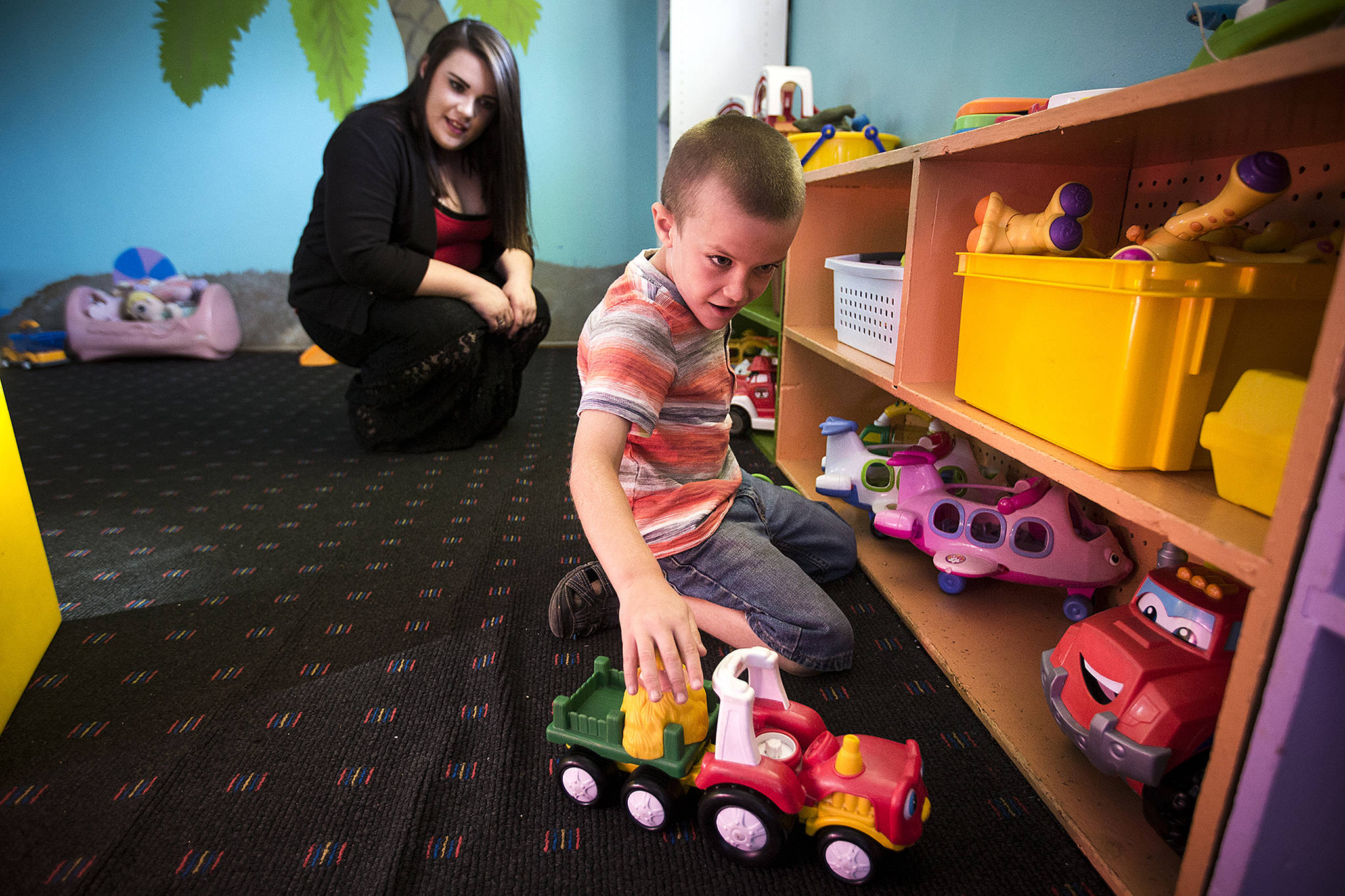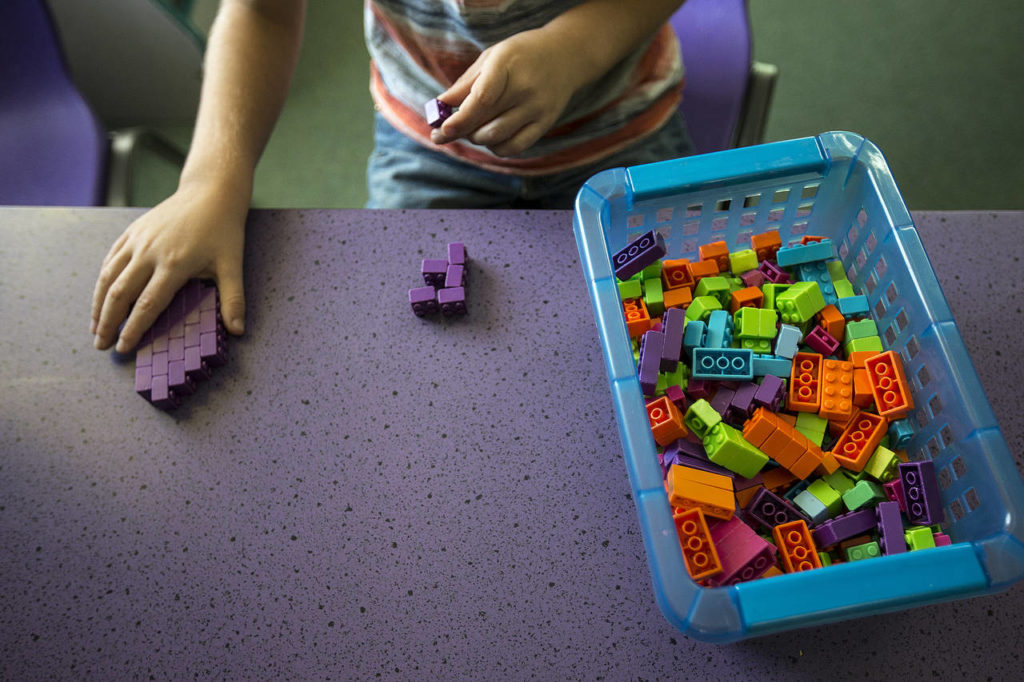MUKILTEO — Each morning since the school year began 11 days ago, Joshua Latimer, 7, has watched other children climb aboard a school bus.
But he hasn’t been able to join them.
“He’s very upset that he sees his friends on the bus and he doesn’t get to go,” said his mom, Leigh Anne Latimer. “He loves riding the bus and going to school.”
Instead, Joshua, a second-grader at Mukilteo’s Endeavour Elementary School, spends his days at a local child care center, captive to a Catch-22.
Last year, the school district provided Joshua pre- and after-school transportation to the child care center — the only one his mom has been able to find that’s willing to provide special care for her autistic son.
This year, the school district told her it wouldn’t be able to provide transportation.
Joshua first began showing signs of autism at age 2, and was diagnosed with the neurological disorder when he was 5. Autism can affect social interaction, communication and behavior.
Latimer, 26, a single mom, drops Joshua off at the child care center at 7:30 each morning on the way to her job as an architectural designer in Everett.
Another Best Childcare is on the east side of 7th Avenue SE near Everett Mall Way. The school district’s boundary line goes down the middle of the street.
Latimer said she’s been told that since the child care center is outside the district’s boundaries, the school district can’t pick up or drop off her son. He’s literally on the wrong side of the street.
“They said if they did it for Josh this year, they’d have to do it for every child facing the same issue,” Latimer said.
School district spokesman Andy Muntz said he couldn’t talk about the specifics of the case, citing student privacy issues.
“We’ll continue to work with the mother to try to come up with a resolution,” he said.
Scott Raub, a special education liaison for the state Office of Superintendent of Public Instruction, said it’s not uncommon for transportation questions involving special education students to arise at the beginning of a school year.
“It’s sort of typical that I would get a question about crossing district boundaries,” he said. It’s not unusual for school districts to transport special education students to child care centers, he said. The state doesn’t track how many such trips are made by local districts.
School districts are required by federal law to make transportation arrangements for homeless students, sometimes to spots far outside the district.
Latimer said the school district gave her a list of options for getting her son transported from the child care center to school and dropped off there in the afternoon.
They suggested she put an ad in a newspaper. “I’m not thrilled about a complete stranger transporting my son,” she said.
She said they suggested Uber, but the company’s website says that anyone younger than 18 must be accompanied by someone 18 or older.
Latimer says there are no relatives or friends who can assist her. And she’s tried networking with the parents of other special-needs children.
“Nobody has been able to help,” she said. “They just can’t.”
Latimer said the district suggested she change her work schedule.
“I start at 8 a.m.,” she said. She said her boss is sympathetic, but it’s a small office, and he can’t make a change. And getting her son to the child care center after school would still be a problem.
She said the district also suggested that her son could be dropped off at the local Boys &Girls Club.
An environment with up to 60 other kids would be overwhelming for her son because of his sensory issues, she said.
Last year, Josh was in a special education classroom with at least 15 students. “Even that was really hard on Josh,” his mom said. He wasn’t used to that many kids.”
For Josh, everything is magnified — light, sound, touch, she said. “It’s almost as if a dial has been turned all the way up for him when that’s set to a lower point for everyone else.”
Sometimes he’s so sensitive to his clothing that he tells her it hurts him.
At times, even whispering can be too much. “That’s too loud. It hurts my ears,” he tells her.
Latimer said the school district has offered to pick up and drop off her son at another child care center directly across the street, which is within the school district’s boundaries. But that would mean crossing busy Everett Mall Way to reach the child care center he attends.
“I don’t fully trust myself to manage him at an intersection, let alone anyone else doing it,” she said. Her son is strong and can pull away quickly.
He doesn’t react well to passing cars. “It’s so loud, it overstimulates him,” she said.
Latimer contacted the special education department at the state Office of Superintendent of Public Instruction and has requested a hearing on the issue.
The school district has 15 days to offer to set up a meeting to try to resolve the issue.
If no agreement can be reached, a hearing is scheduled before one of the state’s administrative law judges, which ruled in 10 special education cases in 2016, the most recent data available. Decisions can be appealed to federal or state courts.
It could take 45 days for a hearing to be scheduled in the Mukilteo case.
So for now her blond-haired, blue-eyed son who loves to read Dr. Seuss books is spending his days at the child care center.
“It’s not fair to him and not right,” Latimer said. “Joshua cannot keep missing school.”
The child care center doesn’t have the special services her son gets at school, such as speech and occupational therapy, as well as a second grade curriculum tailored to his needs, she said.
The kids at the child care center are substantially younger, from toddlers to 4-year-olds. He doesn’t have 6-, 7-, and 8-year-olds to interact with like when he’s at school.
“He says he misses his friends,” Latimer said. “He wants to be with his teachers and friends.”
Sharon Salyer: 425-339-3486; salyer@heraldnet.com.
Talk to us
> Give us your news tips.
> Send us a letter to the editor.
> More Herald contact information.


























